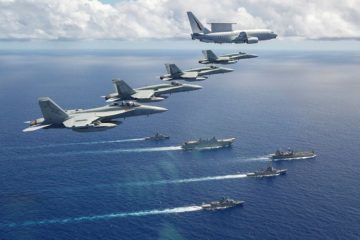The Strategic Update sets out the challenges in Australia’s strategic environment and their implications for Defence planning. It provides a new strategic policy framework to ensure Australia is able – and is understood as willing – to deploy military power to shape our environment, deter actions against our interests and, when required, respond with military force.
The Force Structure Plan includes plans for the acquisition or upgrade of up to 23 different classes of Navy and Army maritime vessels with investment of approximately $50 billion over the decade 2020-30 and up to $137 billion over the period 2020-40.
In total, this represents a plan to invest between $168 – $183 billion out to the completion of the Attack class submarine build in the 2050s.
This is a truly national endeavor involving all States and Territories, industry, science and technology, and the education and training sectors.
Detail on opportunities for Australia’s shipbuilding industry arising from this plan will be included in an update to the Naval Shipbuilding Plan.
On the naval side, the Strategic Update covers both Maritime and Naval Shipbuilding capabilities:
Maritime

- Australia is responsible for one of the world’s largest exclusive economic zones, and is highly dependent on maritime trade.
- The Indo-Pacific region has seen a rapid expansion and modernization of maritime forces, potentially complicating Australia’s ability to protect its interests.
- The 2016 Defence White Paper laid the framework for the most ambitious plan to regenerate the Royal Australian Navy since the Second World War. The 2020 Force Structure Plan will enhance this even further.
Capability Investment – Approximately $75 Billion
Surface and Above Water Combat

Continue to acquire nine Hunter-class Frigates, advanced maritime strike and surface-to-air weapons, and remotely-piloted aerial systems. New investment in precision strike, rationalization of the support helicopter fleet, and the eventual replacement of the Hobart-class destroyer.
Undersea Combat and Surveillance

Continue to acquire 12 Attack-class submarines and upgrade the Collins-class submarines. A new integrated undersea surveillance system will improve Australia’s awareness of its undersea approaches.
Maritime Mine Warfare, Patrol and Geospatial

Continue investment in 12 Arafura-class offshore patrol vessels, and the partnership with the hydrographic industry. New investment in advanced maritime mines, six new Cape Class patrol boats, and up to eight new vessels optimized for mine countermeasures and hydrographic survey.
Maritime Combat Support and Amphibious Warfare

Continue with the acquisition of two Supply-class replenishment vessels, and upgrades to the Royal Australian Navy’s amphibious ships. New investment in two multi-role sealift and replenishment ships, replacement of the ADV Ocean Protector, and a new vessel to support the Pacific Step-Up.
Maritime Command, Control, Communications, Computers, Cyber, Intelligence, Surveillance, Reconnaissance and Electronic Warfare

Continue to modernise maritime communications, the Nulka missile decoy, and electronic warfare systems. New investment in satellite communications, advanced networks, and acoustic analysis.
Opportunities for Australian defense industry: More than 300 Australian companies are currently associated with the construction of the Offshore Patrol Vessels.
Naval Shipbuilding

- The 2020 Force Structure Plan builds on Government’s commitment to continuous naval shipbuilding as set out in the 2016 Defense White Paper.
- The Force Structure Plan includes plans for the acquisition or upgrade of up to 23 different classes of Navy and Army maritime vessels with investment of approximately $50 billion over the decade 2020-30 and up to $137 billion over the period 2020-40. In total, this represents a plan to invest between $168 – $183 billion out to the completion of the Attack class submarine build in the 2050s.
- This is a truly national endeavor involving all States and Territories, industry, science and technology, and the education and training sectors.
- Detail on opportunities for Australia’s shipbuilding industry arising from this plan will be included in an update to the Naval Shipbuilding Plan.
Capability Investment – $168-$183 Billion
Out to the end of the Attack-class submarines build in the 2050s
Surface and Above Water Combat

Continue the build of 9 Hunter-class Frigates and investment in future upgrades, the ongoing assurance of the ANZAC Class Frigates, upgrades to the Hobart-class Destroyers, and the design of the future Destroyer.
Undersea Combat and Surveillance

The build of 12 Attack-class submarines and upgrades and life extension to the Collins-class submarines. Development and build of a next-generation integrated undersea surveillance system, including exploration of optionally crewed and/or un-crewed surface systems and un-crewed undersea systems.
Maritime Combat Support and Amphibious Warfare

Continue to build 12 Arafura Offshore Patrol vessels and the Guardian Class Pacific Patrol Boats. The build of six new Cape Class Patrol Boats, and up to eight new vessels optimised for mine-countermeasures and hydrographic survey, potentially based on the Arafura design
Maritime Combat Support and Amphibious Warfare

Upgrades to the RAN’s Amphibious ships and new investment in two multi-role Sea-Lift and Replenishment Ships and a large Salvage and Repair vessel. Replacement of the ADV Ocean Protector, the Young Endeavour youth training ship and Navy landing craft; and a new vessel to support the Pacific Step-Up.
Army Littoral Manoeuvre
Investment in Army landing craft and Riverine Patrol Vessels.






